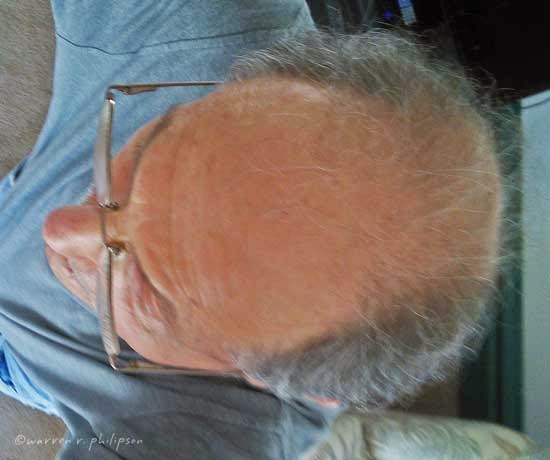I’m sorry. Welcome back. Maybe it won’t be exciting to you; not if you’re not losing your hair. I’m getting balder by the minute. Well, not that fast, but fast.
Here’s the story. You know how stem cell research has been showing great promise on everything including hair generation?
 |
| Hurry up, before there’s no hair to pluck! (Warren’s selfie) |
Why Study Hair Regeneration?
Let me back up. As much as I’d like to restore the flowing locks I once trimmed so cavalierly (see earlier post, Haircuts), I still questioned why medical research money should be spent on hair instead of on life-and-death health issues. Is it purely the potential for financial gain?
 |
| Graphic of hair follicle and environment. (Multiple websites) |
Studying the cycles of hair growth provides insight into how different parts of the human body are interconnected and function. What’s learned in one area of medicine is applicable in other areas.
Plucking Hairs
The hair-plucking study began with the knowledge that an injury to a hair follicle affects the follicle’s adjacent environment. The investigators set out to determine if the follicle’s environment might be used to trigger more hair follicles.
They plucked 200 hair follicles, one-by-one, in different configuration on the backs of mice. Plucking hairs in a low density pattern from a circular area of over 6 millimeters in diameter regenerated no hairs. But plucking hairs in a higher density pattern from circular areas of 3 to 5 millimeters in diameter activated the regeneration of 450 to 1300 hairs, including hairs beyond the plucked circular area.
The underlying principle for the response is quorum sensing, which defines how a system or population reacts to a stimulus that affects some but not all members of the population. In this case, it’s plucking some but not every hair of the hair follicle population.
(If you want the details, molecular and genetic analyses revealed that the injured hair cells signal distress by secreting inflammatory proteins, chemokine ligane 2, which recruit macrophages, a type of white blood cell, to the site of the injury. At a certain concentration, the macrophages secrete molecules, tumor necrosis factor alpha, that activate regeneration of both plucked and unplucked follicles.)
Coupling the immune response with hair regeneration allows skin to disregard minor injury yet meet more serious injury with full-scale activation of stem cells.
Wrap Up
Should I be excited? I know; it’s only mice so far, and you have to have hair to make hair. But don’t you think it’s very cool? And don’t forget that these discoveries for hair regeneration could provide insight for dealing with injury to other organs. As the study’s principal investigator posits, there might be parallel physiological or pathogenic processes.
Anyhow, thanks for stopping by. It’s always appreciated.
P.S.
Hair study in Cell journal:
www.cell.com/cell/abstract/S0092-8674%2815%2900182-8
Articles on study on Science Daily, Medical News Today and Discovery websites:
www.sciencedaily.com/releases/2015/04/150409133407.htm
www.medicalnewstoday.com/articles/292229.php
news.discovery.com/human/health/plucking-hairs-grows-more-hairs-150409.htm
Examples of hair regeneration research with stem cells in PLOS ONE and Nature Communications journals:
journals.plos.org/plosone/article?id=10.1371/journal.pone.0116892
www.nature.com/ncomms/2014/140128/ncomms4071/full/ncomms4071.html
American Hair Loss Association website: www.americanhairloss.org/
Quorum Sensing: en.wikipedia.org/wiki/Quorum_sensing

No comments:
Post a Comment